Analysing Behaviour Management in a Purposeful Learning Environment
VerifiedAdded on 2023/06/10
|8
|3003
|369
Report
AI Summary
This report provides an overview of understanding and managing behaviours in a learning environment. It covers various behaviour management theories, including Bill Rogers, Bruce Tuckman's Forming, Storming, Norming, Performing & Adjourning, and Glasser's Motivational Theory. The report identifies different types of behaviours that can occur, such as withdrawn and disruptive behaviours, and discusses potential factors contributing to these behaviours and their impact. It also includes a personal account reflecting on the application of behavioural theories to create a purposeful learning environment, analysing the effectiveness of the practices, and identifying strengths and areas for improvement. The importance of policies such as zero tolerance and diversity in managing classroom behaviour is also highlighted, along with the role of Maslow's hierarchy of needs in motivating students. Desklib provides this assignment and other study tools for students.
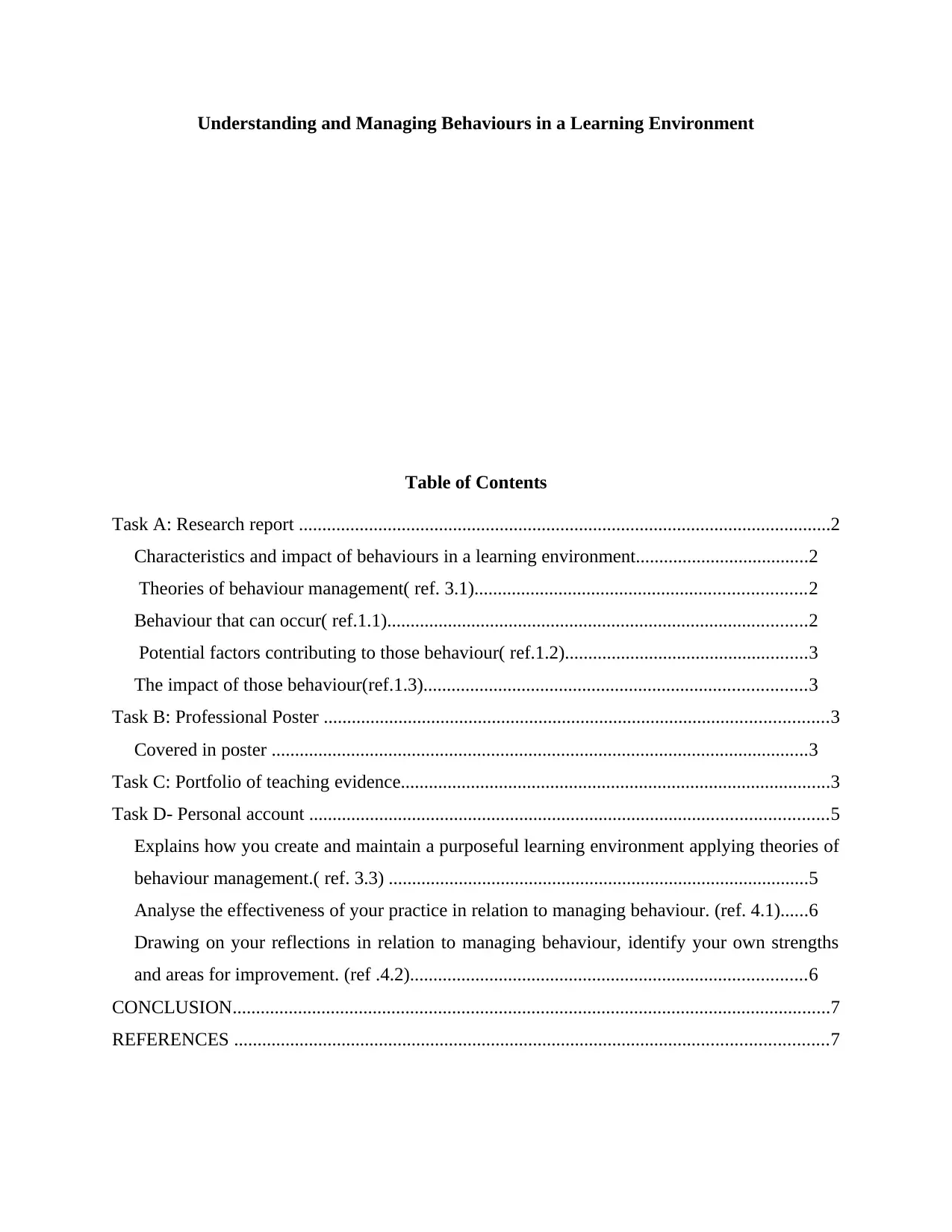
Understanding and Managing Behaviours in a Learning Environment
Table of Contents
Task A: Research report ..................................................................................................................2
Characteristics and impact of behaviours in a learning environment.....................................2
Theories of behaviour management( ref. 3.1).......................................................................2
Behaviour that can occur( ref.1.1)..........................................................................................2
Potential factors contributing to those behaviour( ref.1.2)....................................................3
The impact of those behaviour(ref.1.3)..................................................................................3
Task B: Professional Poster ............................................................................................................3
Covered in poster ...................................................................................................................3
Task C: Portfolio of teaching evidence............................................................................................3
Task D- Personal account ...............................................................................................................5
Explains how you create and maintain a purposeful learning environment applying theories of
behaviour management.( ref. 3.3) ..........................................................................................5
Analyse the effectiveness of your practice in relation to managing behaviour. (ref. 4.1)......6
Drawing on your reflections in relation to managing behaviour, identify your own strengths
and areas for improvement. (ref .4.2).....................................................................................6
CONCLUSION................................................................................................................................7
REFERENCES ...............................................................................................................................7
Table of Contents
Task A: Research report ..................................................................................................................2
Characteristics and impact of behaviours in a learning environment.....................................2
Theories of behaviour management( ref. 3.1).......................................................................2
Behaviour that can occur( ref.1.1)..........................................................................................2
Potential factors contributing to those behaviour( ref.1.2)....................................................3
The impact of those behaviour(ref.1.3)..................................................................................3
Task B: Professional Poster ............................................................................................................3
Covered in poster ...................................................................................................................3
Task C: Portfolio of teaching evidence............................................................................................3
Task D- Personal account ...............................................................................................................5
Explains how you create and maintain a purposeful learning environment applying theories of
behaviour management.( ref. 3.3) ..........................................................................................5
Analyse the effectiveness of your practice in relation to managing behaviour. (ref. 4.1)......6
Drawing on your reflections in relation to managing behaviour, identify your own strengths
and areas for improvement. (ref .4.2).....................................................................................6
CONCLUSION................................................................................................................................7
REFERENCES ...............................................................................................................................7
Paraphrase This Document
Need a fresh take? Get an instant paraphrase of this document with our AI Paraphraser
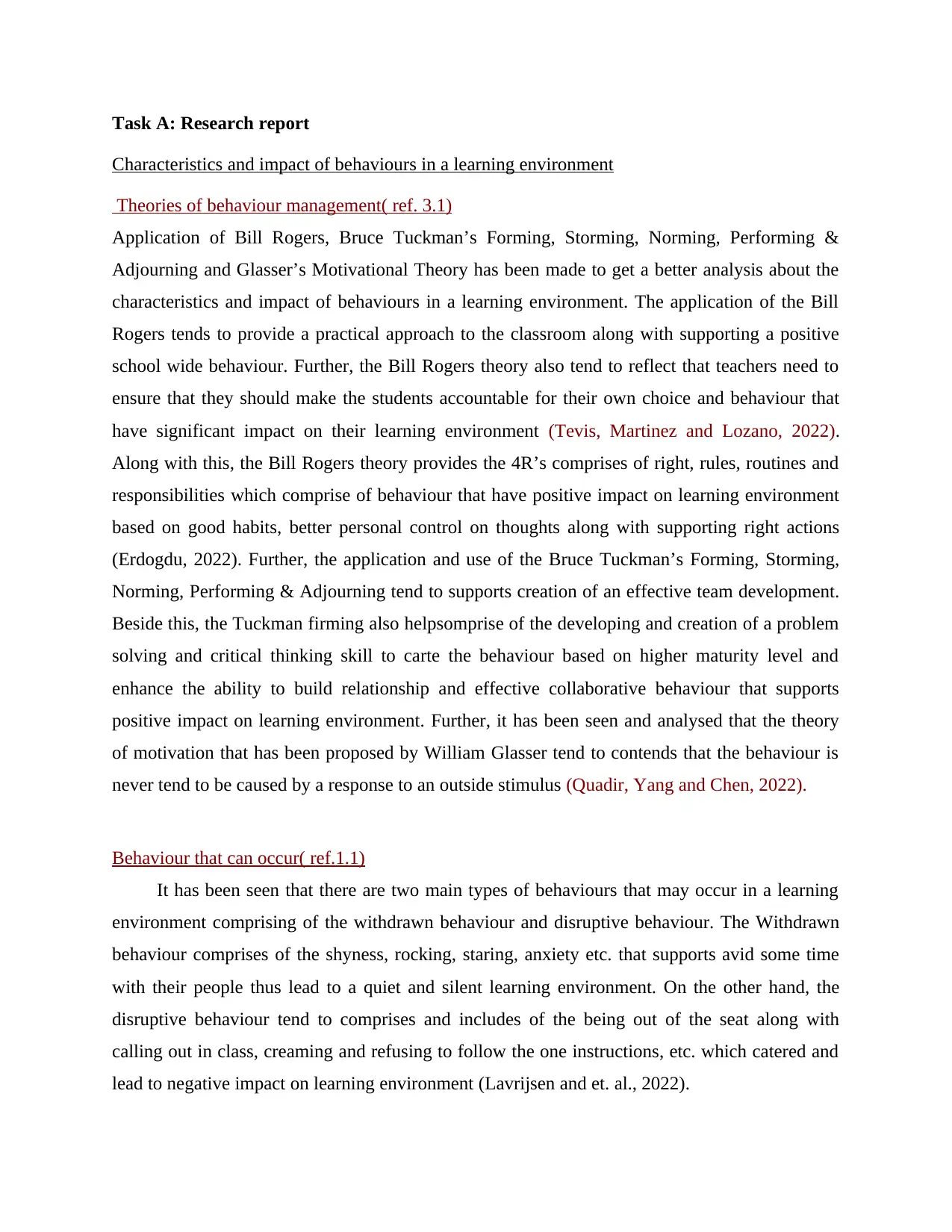
Task A: Research report
Characteristics and impact of behaviours in a learning environment
Theories of behaviour management( ref. 3.1)
Application of Bill Rogers, Bruce Tuckman’s Forming, Storming, Norming, Performing &
Adjourning and Glasser’s Motivational Theory has been made to get a better analysis about the
characteristics and impact of behaviours in a learning environment. The application of the Bill
Rogers tends to provide a practical approach to the classroom along with supporting a positive
school wide behaviour. Further, the Bill Rogers theory also tend to reflect that teachers need to
ensure that they should make the students accountable for their own choice and behaviour that
have significant impact on their learning environment (Tevis, Martinez and Lozano, 2022).
Along with this, the Bill Rogers theory provides the 4R’s comprises of right, rules, routines and
responsibilities which comprise of behaviour that have positive impact on learning environment
based on good habits, better personal control on thoughts along with supporting right actions
(Erdogdu, 2022). Further, the application and use of the Bruce Tuckman’s Forming, Storming,
Norming, Performing & Adjourning tend to supports creation of an effective team development.
Beside this, the Tuckman firming also helpsomprise of the developing and creation of a problem
solving and critical thinking skill to carte the behaviour based on higher maturity level and
enhance the ability to build relationship and effective collaborative behaviour that supports
positive impact on learning environment. Further, it has been seen and analysed that the theory
of motivation that has been proposed by William Glasser tend to contends that the behaviour is
never tend to be caused by a response to an outside stimulus (Quadir, Yang and Chen, 2022).
Behaviour that can occur( ref.1.1)
It has been seen that there are two main types of behaviours that may occur in a learning
environment comprising of the withdrawn behaviour and disruptive behaviour. The Withdrawn
behaviour comprises of the shyness, rocking, staring, anxiety etc. that supports avid some time
with their people thus lead to a quiet and silent learning environment. On the other hand, the
disruptive behaviour tend to comprises and includes of the being out of the seat along with
calling out in class, creaming and refusing to follow the one instructions, etc. which catered and
lead to negative impact on learning environment (Lavrijsen and et. al., 2022).
Characteristics and impact of behaviours in a learning environment
Theories of behaviour management( ref. 3.1)
Application of Bill Rogers, Bruce Tuckman’s Forming, Storming, Norming, Performing &
Adjourning and Glasser’s Motivational Theory has been made to get a better analysis about the
characteristics and impact of behaviours in a learning environment. The application of the Bill
Rogers tends to provide a practical approach to the classroom along with supporting a positive
school wide behaviour. Further, the Bill Rogers theory also tend to reflect that teachers need to
ensure that they should make the students accountable for their own choice and behaviour that
have significant impact on their learning environment (Tevis, Martinez and Lozano, 2022).
Along with this, the Bill Rogers theory provides the 4R’s comprises of right, rules, routines and
responsibilities which comprise of behaviour that have positive impact on learning environment
based on good habits, better personal control on thoughts along with supporting right actions
(Erdogdu, 2022). Further, the application and use of the Bruce Tuckman’s Forming, Storming,
Norming, Performing & Adjourning tend to supports creation of an effective team development.
Beside this, the Tuckman firming also helpsomprise of the developing and creation of a problem
solving and critical thinking skill to carte the behaviour based on higher maturity level and
enhance the ability to build relationship and effective collaborative behaviour that supports
positive impact on learning environment. Further, it has been seen and analysed that the theory
of motivation that has been proposed by William Glasser tend to contends that the behaviour is
never tend to be caused by a response to an outside stimulus (Quadir, Yang and Chen, 2022).
Behaviour that can occur( ref.1.1)
It has been seen that there are two main types of behaviours that may occur in a learning
environment comprising of the withdrawn behaviour and disruptive behaviour. The Withdrawn
behaviour comprises of the shyness, rocking, staring, anxiety etc. that supports avid some time
with their people thus lead to a quiet and silent learning environment. On the other hand, the
disruptive behaviour tend to comprises and includes of the being out of the seat along with
calling out in class, creaming and refusing to follow the one instructions, etc. which catered and
lead to negative impact on learning environment (Lavrijsen and et. al., 2022).
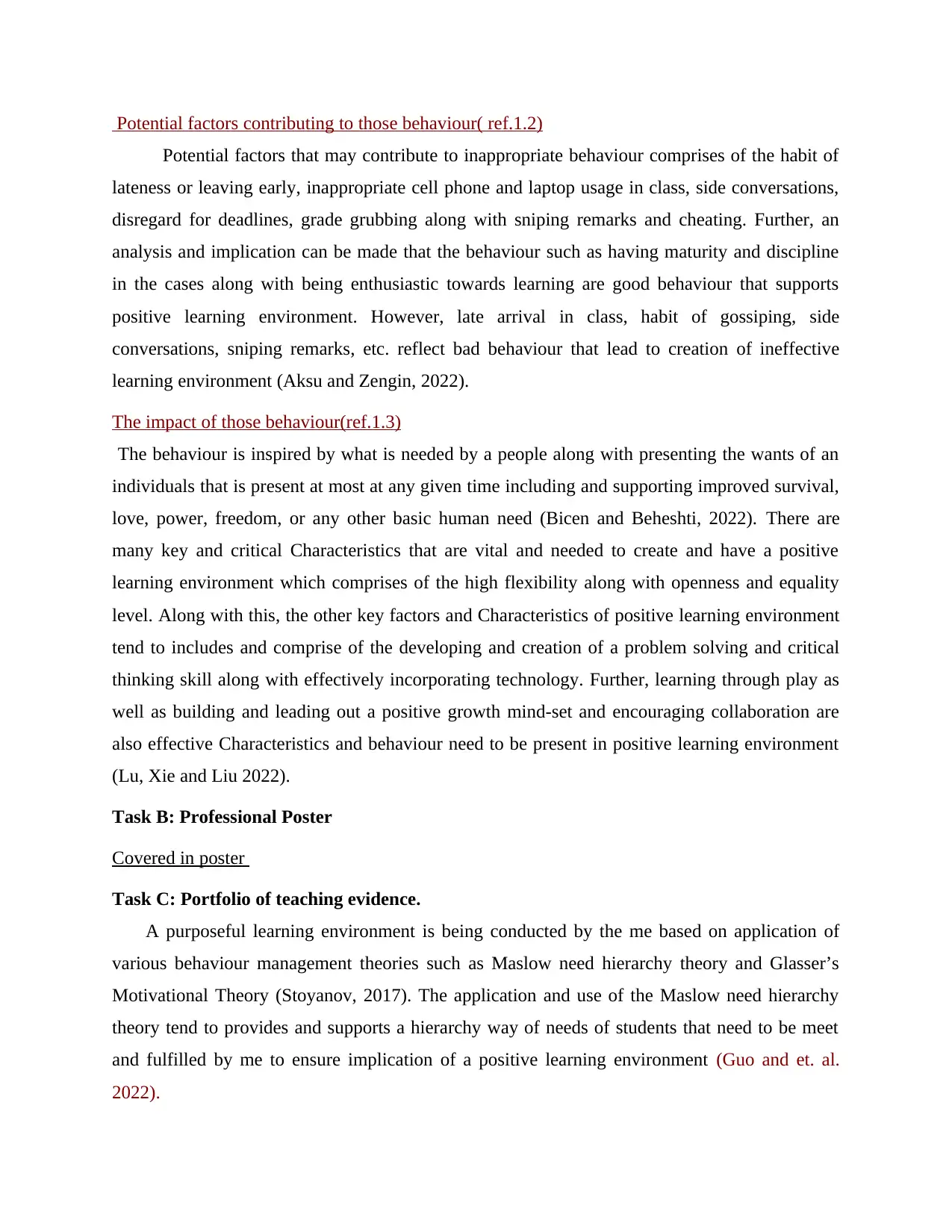
Potential factors contributing to those behaviour( ref.1.2)
Potential factors that may contribute to inappropriate behaviour comprises of the habit of
lateness or leaving early, inappropriate cell phone and laptop usage in class, side conversations,
disregard for deadlines, grade grubbing along with sniping remarks and cheating. Further, an
analysis and implication can be made that the behaviour such as having maturity and discipline
in the cases along with being enthusiastic towards learning are good behaviour that supports
positive learning environment. However, late arrival in class, habit of gossiping, side
conversations, sniping remarks, etc. reflect bad behaviour that lead to creation of ineffective
learning environment (Aksu and Zengin, 2022).
The impact of those behaviour(ref.1.3)
The behaviour is inspired by what is needed by a people along with presenting the wants of an
individuals that is present at most at any given time including and supporting improved survival,
love, power, freedom, or any other basic human need (Bicen and Beheshti, 2022). There are
many key and critical Characteristics that are vital and needed to create and have a positive
learning environment which comprises of the high flexibility along with openness and equality
level. Along with this, the other key factors and Characteristics of positive learning environment
tend to includes and comprise of the developing and creation of a problem solving and critical
thinking skill along with effectively incorporating technology. Further, learning through play as
well as building and leading out a positive growth mind-set and encouraging collaboration are
also effective Characteristics and behaviour need to be present in positive learning environment
(Lu, Xie and Liu 2022).
Task B: Professional Poster
Covered in poster
Task C: Portfolio of teaching evidence.
A purposeful learning environment is being conducted by the me based on application of
various behaviour management theories such as Maslow need hierarchy theory and Glasser’s
Motivational Theory (Stoyanov, 2017). The application and use of the Maslow need hierarchy
theory tend to provides and supports a hierarchy way of needs of students that need to be meet
and fulfilled by me to ensure implication of a positive learning environment (Guo and et. al.
2022).
Potential factors that may contribute to inappropriate behaviour comprises of the habit of
lateness or leaving early, inappropriate cell phone and laptop usage in class, side conversations,
disregard for deadlines, grade grubbing along with sniping remarks and cheating. Further, an
analysis and implication can be made that the behaviour such as having maturity and discipline
in the cases along with being enthusiastic towards learning are good behaviour that supports
positive learning environment. However, late arrival in class, habit of gossiping, side
conversations, sniping remarks, etc. reflect bad behaviour that lead to creation of ineffective
learning environment (Aksu and Zengin, 2022).
The impact of those behaviour(ref.1.3)
The behaviour is inspired by what is needed by a people along with presenting the wants of an
individuals that is present at most at any given time including and supporting improved survival,
love, power, freedom, or any other basic human need (Bicen and Beheshti, 2022). There are
many key and critical Characteristics that are vital and needed to create and have a positive
learning environment which comprises of the high flexibility along with openness and equality
level. Along with this, the other key factors and Characteristics of positive learning environment
tend to includes and comprise of the developing and creation of a problem solving and critical
thinking skill along with effectively incorporating technology. Further, learning through play as
well as building and leading out a positive growth mind-set and encouraging collaboration are
also effective Characteristics and behaviour need to be present in positive learning environment
(Lu, Xie and Liu 2022).
Task B: Professional Poster
Covered in poster
Task C: Portfolio of teaching evidence.
A purposeful learning environment is being conducted by the me based on application of
various behaviour management theories such as Maslow need hierarchy theory and Glasser’s
Motivational Theory (Stoyanov, 2017). The application and use of the Maslow need hierarchy
theory tend to provides and supports a hierarchy way of needs of students that need to be meet
and fulfilled by me to ensure implication of a positive learning environment (Guo and et. al.
2022).
⊘ This is a preview!⊘
Do you want full access?
Subscribe today to unlock all pages.

Trusted by 1+ million students worldwide
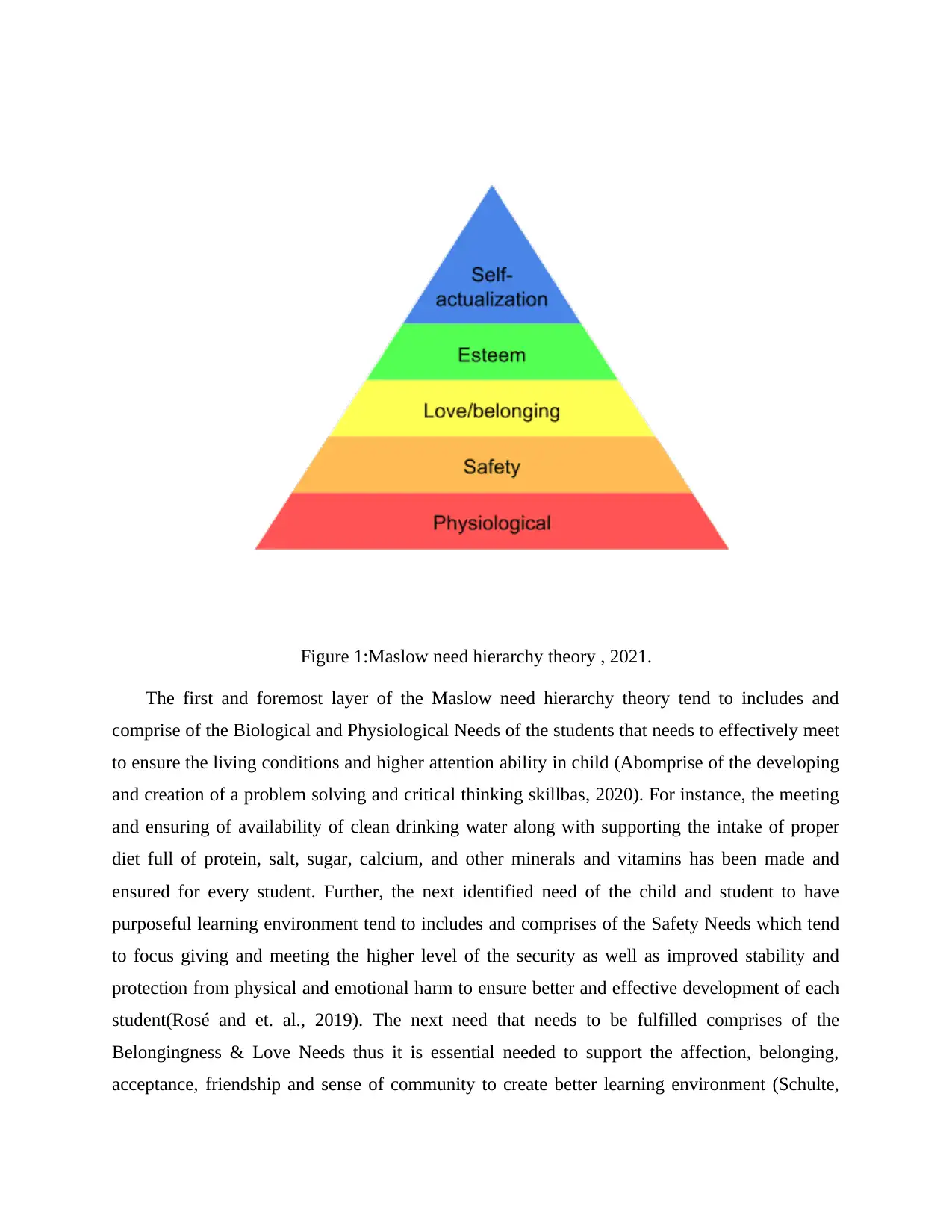
Figure 1:Maslow need hierarchy theory , 2021.
The first and foremost layer of the Maslow need hierarchy theory tend to includes and
comprise of the Biological and Physiological Needs of the students that needs to effectively meet
to ensure the living conditions and higher attention ability in child (Abomprise of the developing
and creation of a problem solving and critical thinking skillbas, 2020). For instance, the meeting
and ensuring of availability of clean drinking water along with supporting the intake of proper
diet full of protein, salt, sugar, calcium, and other minerals and vitamins has been made and
ensured for every student. Further, the next identified need of the child and student to have
purposeful learning environment tend to includes and comprises of the Safety Needs which tend
to focus giving and meeting the higher level of the security as well as improved stability and
protection from physical and emotional harm to ensure better and effective development of each
student(Rosé and et. al., 2019). The next need that needs to be fulfilled comprises of the
Belongingness & Love Needs thus it is essential needed to support the affection, belonging,
acceptance, friendship and sense of community to create better learning environment (Schulte,
The first and foremost layer of the Maslow need hierarchy theory tend to includes and
comprise of the Biological and Physiological Needs of the students that needs to effectively meet
to ensure the living conditions and higher attention ability in child (Abomprise of the developing
and creation of a problem solving and critical thinking skillbas, 2020). For instance, the meeting
and ensuring of availability of clean drinking water along with supporting the intake of proper
diet full of protein, salt, sugar, calcium, and other minerals and vitamins has been made and
ensured for every student. Further, the next identified need of the child and student to have
purposeful learning environment tend to includes and comprises of the Safety Needs which tend
to focus giving and meeting the higher level of the security as well as improved stability and
protection from physical and emotional harm to ensure better and effective development of each
student(Rosé and et. al., 2019). The next need that needs to be fulfilled comprises of the
Belongingness & Love Needs thus it is essential needed to support the affection, belonging,
acceptance, friendship and sense of community to create better learning environment (Schulte,
Paraphrase This Document
Need a fresh take? Get an instant paraphrase of this document with our AI Paraphraser
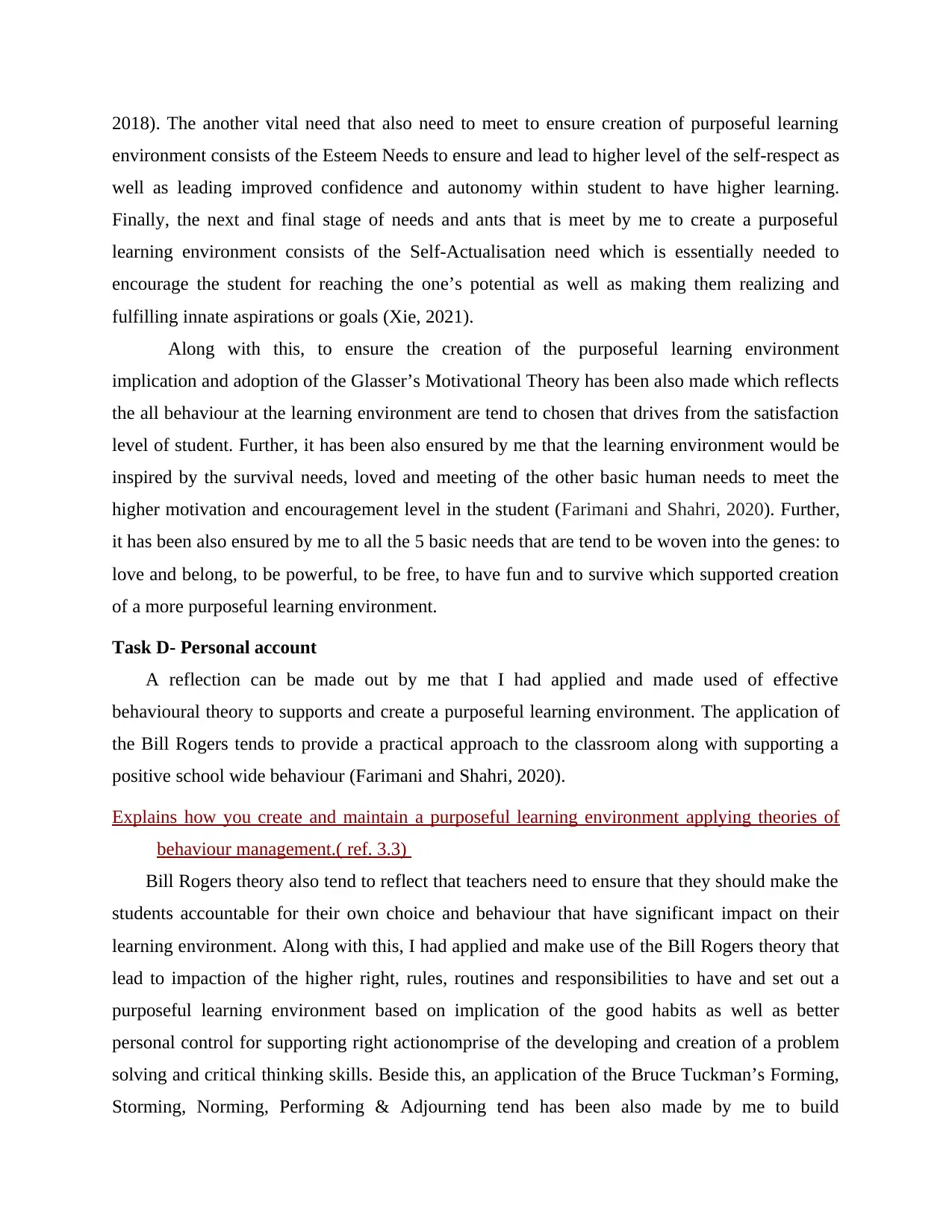
2018). The another vital need that also need to meet to ensure creation of purposeful learning
environment consists of the Esteem Needs to ensure and lead to higher level of the self-respect as
well as leading improved confidence and autonomy within student to have higher learning.
Finally, the next and final stage of needs and ants that is meet by me to create a purposeful
learning environment consists of the Self-Actualisation need which is essentially needed to
encourage the student for reaching the one’s potential as well as making them realizing and
fulfilling innate aspirations or goals (Xie, 2021).
Along with this, to ensure the creation of the purposeful learning environment
implication and adoption of the Glasser’s Motivational Theory has been also made which reflects
the all behaviour at the learning environment are tend to chosen that drives from the satisfaction
level of student. Further, it has been also ensured by me that the learning environment would be
inspired by the survival needs, loved and meeting of the other basic human needs to meet the
higher motivation and encouragement level in the student (Farimani and Shahri, 2020). Further,
it has been also ensured by me to all the 5 basic needs that are tend to be woven into the genes: to
love and belong, to be powerful, to be free, to have fun and to survive which supported creation
of a more purposeful learning environment.
Task D- Personal account
A reflection can be made out by me that I had applied and made used of effective
behavioural theory to supports and create a purposeful learning environment. The application of
the Bill Rogers tends to provide a practical approach to the classroom along with supporting a
positive school wide behaviour (Farimani and Shahri, 2020).
Explains how you create and maintain a purposeful learning environment applying theories of
behaviour management.( ref. 3.3)
Bill Rogers theory also tend to reflect that teachers need to ensure that they should make the
students accountable for their own choice and behaviour that have significant impact on their
learning environment. Along with this, I had applied and make use of the Bill Rogers theory that
lead to impaction of the higher right, rules, routines and responsibilities to have and set out a
purposeful learning environment based on implication of the good habits as well as better
personal control for supporting right actionomprise of the developing and creation of a problem
solving and critical thinking skills. Beside this, an application of the Bruce Tuckman’s Forming,
Storming, Norming, Performing & Adjourning tend has been also made by me to build
environment consists of the Esteem Needs to ensure and lead to higher level of the self-respect as
well as leading improved confidence and autonomy within student to have higher learning.
Finally, the next and final stage of needs and ants that is meet by me to create a purposeful
learning environment consists of the Self-Actualisation need which is essentially needed to
encourage the student for reaching the one’s potential as well as making them realizing and
fulfilling innate aspirations or goals (Xie, 2021).
Along with this, to ensure the creation of the purposeful learning environment
implication and adoption of the Glasser’s Motivational Theory has been also made which reflects
the all behaviour at the learning environment are tend to chosen that drives from the satisfaction
level of student. Further, it has been also ensured by me that the learning environment would be
inspired by the survival needs, loved and meeting of the other basic human needs to meet the
higher motivation and encouragement level in the student (Farimani and Shahri, 2020). Further,
it has been also ensured by me to all the 5 basic needs that are tend to be woven into the genes: to
love and belong, to be powerful, to be free, to have fun and to survive which supported creation
of a more purposeful learning environment.
Task D- Personal account
A reflection can be made out by me that I had applied and made used of effective
behavioural theory to supports and create a purposeful learning environment. The application of
the Bill Rogers tends to provide a practical approach to the classroom along with supporting a
positive school wide behaviour (Farimani and Shahri, 2020).
Explains how you create and maintain a purposeful learning environment applying theories of
behaviour management.( ref. 3.3)
Bill Rogers theory also tend to reflect that teachers need to ensure that they should make the
students accountable for their own choice and behaviour that have significant impact on their
learning environment. Along with this, I had applied and make use of the Bill Rogers theory that
lead to impaction of the higher right, rules, routines and responsibilities to have and set out a
purposeful learning environment based on implication of the good habits as well as better
personal control for supporting right actionomprise of the developing and creation of a problem
solving and critical thinking skills. Beside this, an application of the Bruce Tuckman’s Forming,
Storming, Norming, Performing & Adjourning tend has been also made by me to build
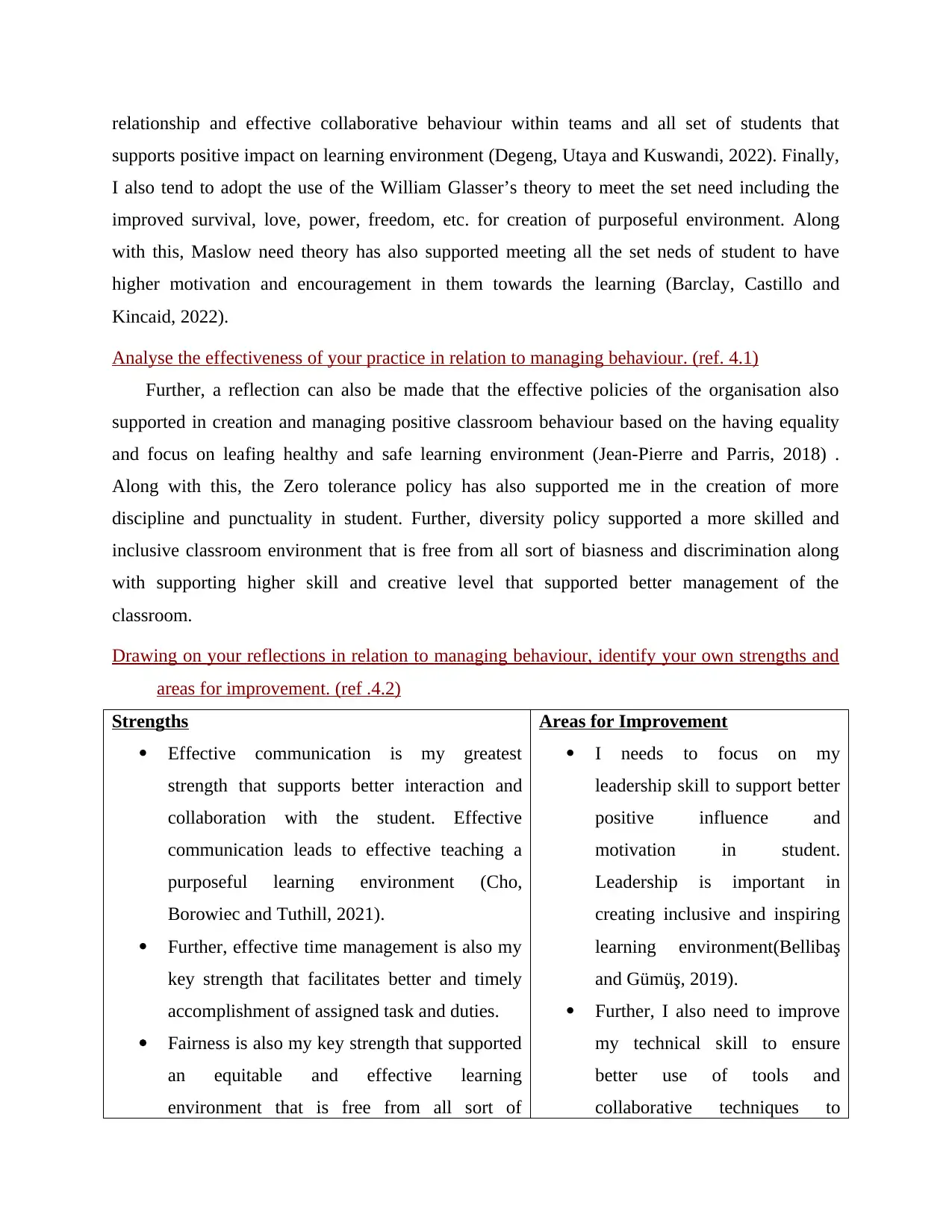
relationship and effective collaborative behaviour within teams and all set of students that
supports positive impact on learning environment (Degeng, Utaya and Kuswandi, 2022). Finally,
I also tend to adopt the use of the William Glasser’s theory to meet the set need including the
improved survival, love, power, freedom, etc. for creation of purposeful environment. Along
with this, Maslow need theory has also supported meeting all the set neds of student to have
higher motivation and encouragement in them towards the learning (Barclay, Castillo and
Kincaid, 2022).
Analyse the effectiveness of your practice in relation to managing behaviour. (ref. 4.1)
Further, a reflection can also be made that the effective policies of the organisation also
supported in creation and managing positive classroom behaviour based on the having equality
and focus on leafing healthy and safe learning environment (Jean-Pierre and Parris, 2018) .
Along with this, the Zero tolerance policy has also supported me in the creation of more
discipline and punctuality in student. Further, diversity policy supported a more skilled and
inclusive classroom environment that is free from all sort of biasness and discrimination along
with supporting higher skill and creative level that supported better management of the
classroom.
Drawing on your reflections in relation to managing behaviour, identify your own strengths and
areas for improvement. (ref .4.2)
Strengths
Effective communication is my greatest
strength that supports better interaction and
collaboration with the student. Effective
communication leads to effective teaching a
purposeful learning environment (Cho,
Borowiec and Tuthill, 2021).
Further, effective time management is also my
key strength that facilitates better and timely
accomplishment of assigned task and duties.
Fairness is also my key strength that supported
an equitable and effective learning
environment that is free from all sort of
Areas for Improvement
I needs to focus on my
leadership skill to support better
positive influence and
motivation in student.
Leadership is important in
creating inclusive and inspiring
learning environment(Bellibaş
and Gümüş, 2019).
Further, I also need to improve
my technical skill to ensure
better use of tools and
collaborative techniques to
supports positive impact on learning environment (Degeng, Utaya and Kuswandi, 2022). Finally,
I also tend to adopt the use of the William Glasser’s theory to meet the set need including the
improved survival, love, power, freedom, etc. for creation of purposeful environment. Along
with this, Maslow need theory has also supported meeting all the set neds of student to have
higher motivation and encouragement in them towards the learning (Barclay, Castillo and
Kincaid, 2022).
Analyse the effectiveness of your practice in relation to managing behaviour. (ref. 4.1)
Further, a reflection can also be made that the effective policies of the organisation also
supported in creation and managing positive classroom behaviour based on the having equality
and focus on leafing healthy and safe learning environment (Jean-Pierre and Parris, 2018) .
Along with this, the Zero tolerance policy has also supported me in the creation of more
discipline and punctuality in student. Further, diversity policy supported a more skilled and
inclusive classroom environment that is free from all sort of biasness and discrimination along
with supporting higher skill and creative level that supported better management of the
classroom.
Drawing on your reflections in relation to managing behaviour, identify your own strengths and
areas for improvement. (ref .4.2)
Strengths
Effective communication is my greatest
strength that supports better interaction and
collaboration with the student. Effective
communication leads to effective teaching a
purposeful learning environment (Cho,
Borowiec and Tuthill, 2021).
Further, effective time management is also my
key strength that facilitates better and timely
accomplishment of assigned task and duties.
Fairness is also my key strength that supported
an equitable and effective learning
environment that is free from all sort of
Areas for Improvement
I needs to focus on my
leadership skill to support better
positive influence and
motivation in student.
Leadership is important in
creating inclusive and inspiring
learning environment(Bellibaş
and Gümüş, 2019).
Further, I also need to improve
my technical skill to ensure
better use of tools and
collaborative techniques to
⊘ This is a preview!⊘
Do you want full access?
Subscribe today to unlock all pages.

Trusted by 1+ million students worldwide
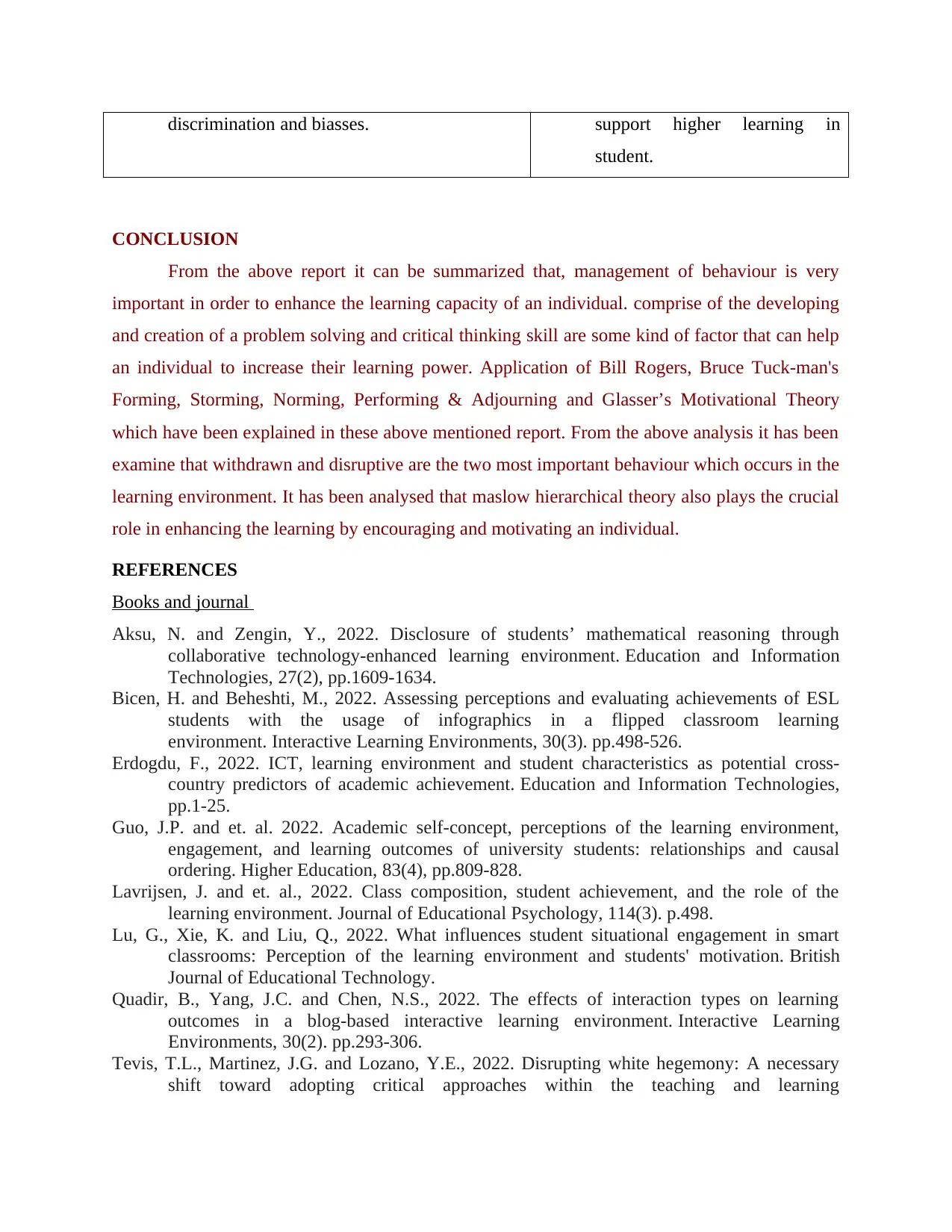
discrimination and biasses. support higher learning in
student.
CONCLUSION
From the above report it can be summarized that, management of behaviour is very
important in order to enhance the learning capacity of an individual. comprise of the developing
and creation of a problem solving and critical thinking skill are some kind of factor that can help
an individual to increase their learning power. Application of Bill Rogers, Bruce Tuck-man's
Forming, Storming, Norming, Performing & Adjourning and Glasser’s Motivational Theory
which have been explained in these above mentioned report. From the above analysis it has been
examine that withdrawn and disruptive are the two most important behaviour which occurs in the
learning environment. It has been analysed that maslow hierarchical theory also plays the crucial
role in enhancing the learning by encouraging and motivating an individual.
REFERENCES
Books and journal
Aksu, N. and Zengin, Y., 2022. Disclosure of students’ mathematical reasoning through
collaborative technology-enhanced learning environment. Education and Information
Technologies, 27(2), pp.1609-1634.
Bicen, H. and Beheshti, M., 2022. Assessing perceptions and evaluating achievements of ESL
students with the usage of infographics in a flipped classroom learning
environment. Interactive Learning Environments, 30(3). pp.498-526.
Erdogdu, F., 2022. ICT, learning environment and student characteristics as potential cross-
country predictors of academic achievement. Education and Information Technologies,
pp.1-25.
Guo, J.P. and et. al. 2022. Academic self-concept, perceptions of the learning environment,
engagement, and learning outcomes of university students: relationships and causal
ordering. Higher Education, 83(4), pp.809-828.
Lavrijsen, J. and et. al., 2022. Class composition, student achievement, and the role of the
learning environment. Journal of Educational Psychology, 114(3). p.498.
Lu, G., Xie, K. and Liu, Q., 2022. What influences student situational engagement in smart
classrooms: Perception of the learning environment and students' motivation. British
Journal of Educational Technology.
Quadir, B., Yang, J.C. and Chen, N.S., 2022. The effects of interaction types on learning
outcomes in a blog-based interactive learning environment. Interactive Learning
Environments, 30(2). pp.293-306.
Tevis, T.L., Martinez, J.G. and Lozano, Y.E., 2022. Disrupting white hegemony: A necessary
shift toward adopting critical approaches within the teaching and learning
student.
CONCLUSION
From the above report it can be summarized that, management of behaviour is very
important in order to enhance the learning capacity of an individual. comprise of the developing
and creation of a problem solving and critical thinking skill are some kind of factor that can help
an individual to increase their learning power. Application of Bill Rogers, Bruce Tuck-man's
Forming, Storming, Norming, Performing & Adjourning and Glasser’s Motivational Theory
which have been explained in these above mentioned report. From the above analysis it has been
examine that withdrawn and disruptive are the two most important behaviour which occurs in the
learning environment. It has been analysed that maslow hierarchical theory also plays the crucial
role in enhancing the learning by encouraging and motivating an individual.
REFERENCES
Books and journal
Aksu, N. and Zengin, Y., 2022. Disclosure of students’ mathematical reasoning through
collaborative technology-enhanced learning environment. Education and Information
Technologies, 27(2), pp.1609-1634.
Bicen, H. and Beheshti, M., 2022. Assessing perceptions and evaluating achievements of ESL
students with the usage of infographics in a flipped classroom learning
environment. Interactive Learning Environments, 30(3). pp.498-526.
Erdogdu, F., 2022. ICT, learning environment and student characteristics as potential cross-
country predictors of academic achievement. Education and Information Technologies,
pp.1-25.
Guo, J.P. and et. al. 2022. Academic self-concept, perceptions of the learning environment,
engagement, and learning outcomes of university students: relationships and causal
ordering. Higher Education, 83(4), pp.809-828.
Lavrijsen, J. and et. al., 2022. Class composition, student achievement, and the role of the
learning environment. Journal of Educational Psychology, 114(3). p.498.
Lu, G., Xie, K. and Liu, Q., 2022. What influences student situational engagement in smart
classrooms: Perception of the learning environment and students' motivation. British
Journal of Educational Technology.
Quadir, B., Yang, J.C. and Chen, N.S., 2022. The effects of interaction types on learning
outcomes in a blog-based interactive learning environment. Interactive Learning
Environments, 30(2). pp.293-306.
Tevis, T.L., Martinez, J.G. and Lozano, Y.E., 2022. Disrupting white hegemony: A necessary
shift toward adopting critical approaches within the teaching and learning
Paraphrase This Document
Need a fresh take? Get an instant paraphrase of this document with our AI Paraphraser
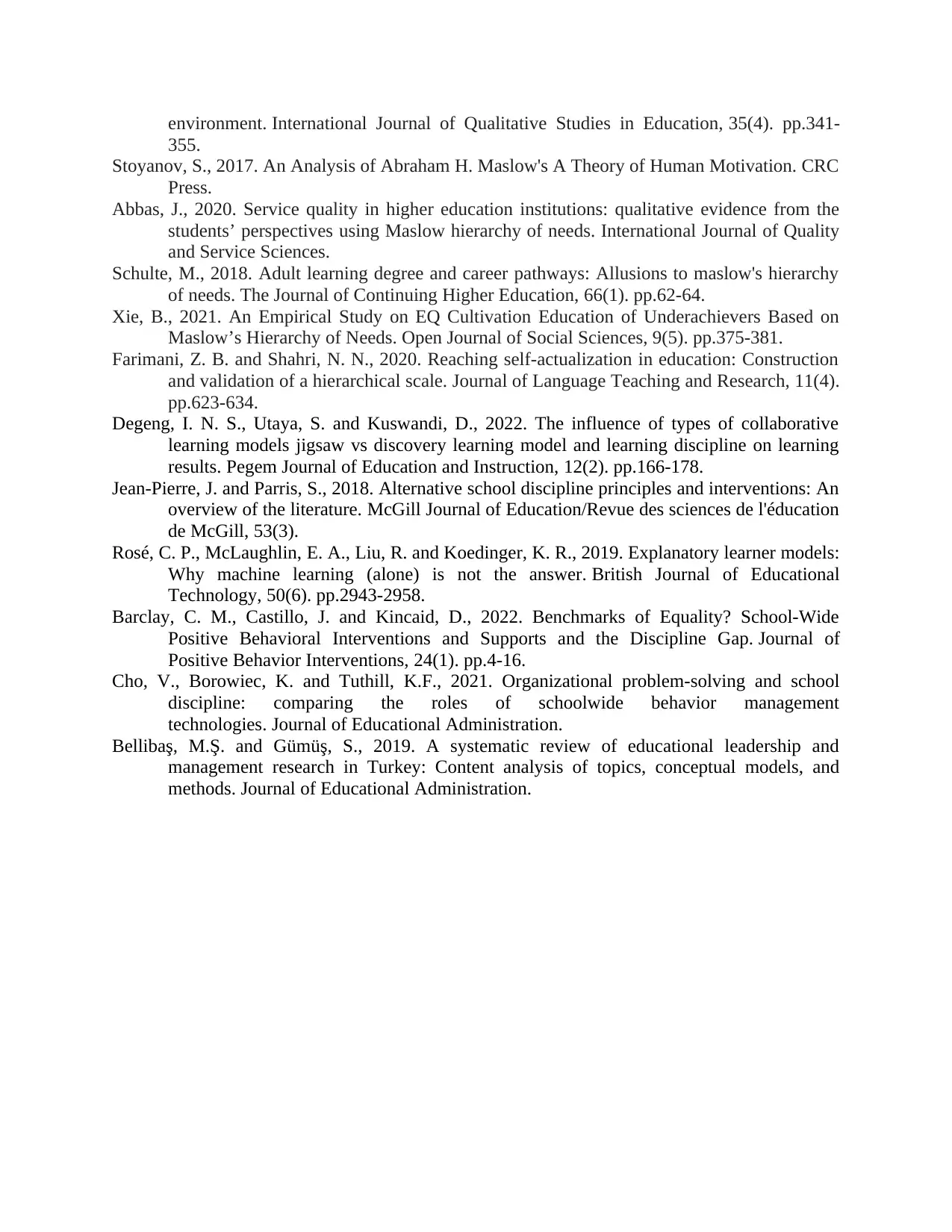
environment. International Journal of Qualitative Studies in Education, 35(4). pp.341-
355.
Stoyanov, S., 2017. An Analysis of Abraham H. Maslow's A Theory of Human Motivation. CRC
Press.
Abbas, J., 2020. Service quality in higher education institutions: qualitative evidence from the
students’ perspectives using Maslow hierarchy of needs. International Journal of Quality
and Service Sciences.
Schulte, M., 2018. Adult learning degree and career pathways: Allusions to maslow's hierarchy
of needs. The Journal of Continuing Higher Education, 66(1). pp.62-64.
Xie, B., 2021. An Empirical Study on EQ Cultivation Education of Underachievers Based on
Maslow’s Hierarchy of Needs. Open Journal of Social Sciences, 9(5). pp.375-381.
Farimani, Z. B. and Shahri, N. N., 2020. Reaching self-actualization in education: Construction
and validation of a hierarchical scale. Journal of Language Teaching and Research, 11(4).
pp.623-634.
Degeng, I. N. S., Utaya, S. and Kuswandi, D., 2022. The influence of types of collaborative
learning models jigsaw vs discovery learning model and learning discipline on learning
results. Pegem Journal of Education and Instruction, 12(2). pp.166-178.
Jean-Pierre, J. and Parris, S., 2018. Alternative school discipline principles and interventions: An
overview of the literature. McGill Journal of Education/Revue des sciences de l'éducation
de McGill, 53(3).
Rosé, C. P., McLaughlin, E. A., Liu, R. and Koedinger, K. R., 2019. Explanatory learner models:
Why machine learning (alone) is not the answer. British Journal of Educational
Technology, 50(6). pp.2943-2958.
Barclay, C. M., Castillo, J. and Kincaid, D., 2022. Benchmarks of Equality? School-Wide
Positive Behavioral Interventions and Supports and the Discipline Gap. Journal of
Positive Behavior Interventions, 24(1). pp.4-16.
Cho, V., Borowiec, K. and Tuthill, K.F., 2021. Organizational problem-solving and school
discipline: comparing the roles of schoolwide behavior management
technologies. Journal of Educational Administration.
Bellibaş, M.Ş. and Gümüş, S., 2019. A systematic review of educational leadership and
management research in Turkey: Content analysis of topics, conceptual models, and
methods. Journal of Educational Administration.
355.
Stoyanov, S., 2017. An Analysis of Abraham H. Maslow's A Theory of Human Motivation. CRC
Press.
Abbas, J., 2020. Service quality in higher education institutions: qualitative evidence from the
students’ perspectives using Maslow hierarchy of needs. International Journal of Quality
and Service Sciences.
Schulte, M., 2018. Adult learning degree and career pathways: Allusions to maslow's hierarchy
of needs. The Journal of Continuing Higher Education, 66(1). pp.62-64.
Xie, B., 2021. An Empirical Study on EQ Cultivation Education of Underachievers Based on
Maslow’s Hierarchy of Needs. Open Journal of Social Sciences, 9(5). pp.375-381.
Farimani, Z. B. and Shahri, N. N., 2020. Reaching self-actualization in education: Construction
and validation of a hierarchical scale. Journal of Language Teaching and Research, 11(4).
pp.623-634.
Degeng, I. N. S., Utaya, S. and Kuswandi, D., 2022. The influence of types of collaborative
learning models jigsaw vs discovery learning model and learning discipline on learning
results. Pegem Journal of Education and Instruction, 12(2). pp.166-178.
Jean-Pierre, J. and Parris, S., 2018. Alternative school discipline principles and interventions: An
overview of the literature. McGill Journal of Education/Revue des sciences de l'éducation
de McGill, 53(3).
Rosé, C. P., McLaughlin, E. A., Liu, R. and Koedinger, K. R., 2019. Explanatory learner models:
Why machine learning (alone) is not the answer. British Journal of Educational
Technology, 50(6). pp.2943-2958.
Barclay, C. M., Castillo, J. and Kincaid, D., 2022. Benchmarks of Equality? School-Wide
Positive Behavioral Interventions and Supports and the Discipline Gap. Journal of
Positive Behavior Interventions, 24(1). pp.4-16.
Cho, V., Borowiec, K. and Tuthill, K.F., 2021. Organizational problem-solving and school
discipline: comparing the roles of schoolwide behavior management
technologies. Journal of Educational Administration.
Bellibaş, M.Ş. and Gümüş, S., 2019. A systematic review of educational leadership and
management research in Turkey: Content analysis of topics, conceptual models, and
methods. Journal of Educational Administration.
1 out of 8
Your All-in-One AI-Powered Toolkit for Academic Success.
+13062052269
info@desklib.com
Available 24*7 on WhatsApp / Email
![[object Object]](/_next/static/media/star-bottom.7253800d.svg)
Unlock your academic potential
Copyright © 2020–2025 A2Z Services. All Rights Reserved. Developed and managed by ZUCOL.